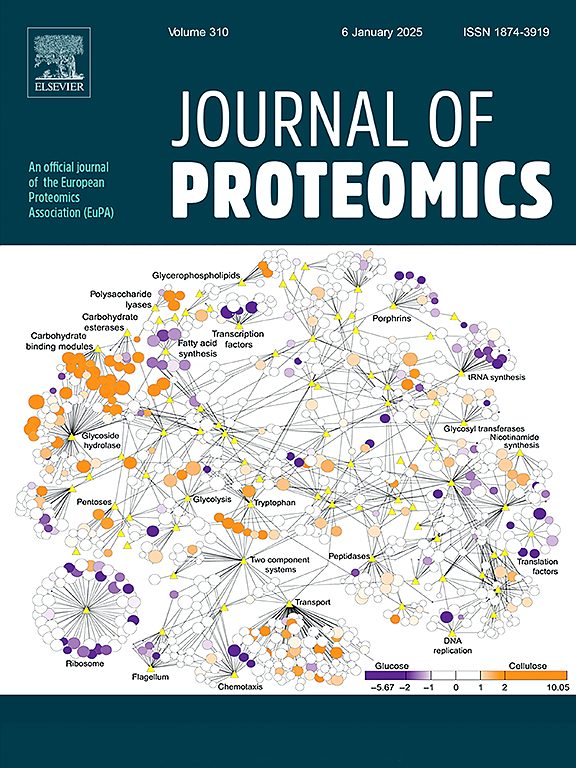直肠癌放疗患者放射性直肠损伤的定量蛋白质组学分析
IF 2.8
2区 生物学
Q2 BIOCHEMICAL RESEARCH METHODS
引用次数: 0
摘要
放射性直肠损伤(RRI)影响直肠癌放疗患者围手术期治疗和术后生活质量。本研究旨在阐明RRI的分子机制,寻找潜在的治疗靶点。苏木精-伊红染色和马松染色评价RRI。最初,使用数据独立获取蛋白质组学对16个直肠样本进行检查,以鉴定差异丰富蛋白(DAPs)。随后,采用平行反应监测(PRM)验证DAP表达。此外,使用酶联免疫吸附试验(ELISA)评估118例直肠癌患者的DAP水平。病理检查显示直肠标本有RRI的表现。共鉴定出1391个dap,其中619个上调,772个下调。功能注释显示,这些蛋白主要参与调节肌动蛋白细胞骨架、代谢途径和免疫途径。富集分析表明,DAPs在巨噬细胞趋化、中性粒细胞胞外陷阱和脂质代谢等途径中显著富集。使用PRM验证相关通路中显著上调的DAPs (LBP、ITIH4、SERPINA3、FN1、PLG、HRG、FGA和SAA1)的表达。ELISA结果显示,RRI组SAA1水平显著升高。总之,我们的研究提供了RRI的蛋白质组学特征,确定了生物学标记和潜在的分子调控机制。放射性肠损伤(RII)显著影响盆腔放疗患者术后生活质量。然而,目前对RII背后机制的理解仍不清楚。本研究采用苏木精-伊红染色和马松染色评价RRI。我们采用数据独立获取蛋白质组学分析来表征与RII相关的蛋白质组学特征。通过这一分析,我们确定了与RII相关的差异表达蛋白(DEPs)和潜在的分子途径。平行反应监测和酶联免疫吸附实验进一步验证了DEPs的表达。我们的发现为RII的预防和治疗策略提供了新的见解,从而有可能改善受影响患者的临床结果和生活质量。本文章由计算机程序翻译,如有差异,请以英文原文为准。

Quantitative proteomics analysis of radiation-induced rectal injury in rectal cancer patients undergoing radiotherapy
Radiation-induced rectal injury (RRI) affects perioperative treatment and the postoperative quality of life in patients with rectal cancer undergoing radiotherapy. This study aimed to clarify the molecular mechanisms of RRI and identify potential therapeutic targets. Hematoxylin-eosin and Masson's staining were utilized to evaluate RRI. Initially, 16 rectal samples were examined using data-independent acquisition proteomics to identify the differentially abundant proteins (DAPs). Subsequently, parallel reaction monitoring (PRM) was employed to validate DAP expression. Furthermore, DAP levels were assessed using enzyme-linked immunosorbent assay (ELISA) in 118 patients with rectal cancer. Pathologic examination revealed manifestations of RRI in rectal samples. A total of 1391 DAPs were identified, with 619 upregulated and 772 downregulated. Functional annotation revealed that these proteins are primarily involved in regulating actin cytoskeleton, metabolic pathways, and immune pathways. Enrichment analysis indicated significant enrichment of DAPs in pathways, including macrophage chemotaxis, neutrophil extracellular traps, and lipid metabolism. The expression of significantly upregulated DAPs (LBP, ITIH4, SERPINA3, FN1, PLG, HRG, FGA, and SAA1) in the relevant pathway was validated using PRM. ELISA revealed that the SAA1 level in the RRI group was significantly high. In conclusion, our study provides a proteomic profile of RRI, identifying biological markers and potential molecular regulatory mechanisms.
Significance
Radiation-induced intestinal injury (RII) significantly impacts the postoperative quality of life in patients undergoing pelvic radiotherapy. However, the current understanding of the mechanism behind RII remains unclear. In this study, Hematoxylin-eosin and Masson's staining were used to assess RRI. We employed data-independent acquisition proteomics analysis to characterize the proteomic profile associated with RII. Through this analysis, we identified differentially expressed proteins(DEPs) and potential molecular pathways implicated in RII. Parallel reaction monitoring and enzyme-linked immunosorbent assay further employed to validate the expression of DEPs. Our findings offer novel insights into the prevention and treatment strategies for RII, thereby potentially improving the clinical outcomes and quality of life for affected patients.
求助全文
通过发布文献求助,成功后即可免费获取论文全文。
去求助
来源期刊

Journal of proteomics
生物-生化研究方法
CiteScore
7.10
自引率
3.00%
发文量
227
审稿时长
73 days
期刊介绍:
Journal of Proteomics is aimed at protein scientists and analytical chemists in the field of proteomics, biomarker discovery, protein analytics, plant proteomics, microbial and animal proteomics, human studies, tissue imaging by mass spectrometry, non-conventional and non-model organism proteomics, and protein bioinformatics. The journal welcomes papers in new and upcoming areas such as metabolomics, genomics, systems biology, toxicogenomics, pharmacoproteomics.
Journal of Proteomics unifies both fundamental scientists and clinicians, and includes translational research. Suggestions for reviews, webinars and thematic issues are welcome.
 求助内容:
求助内容: 应助结果提醒方式:
应助结果提醒方式:


